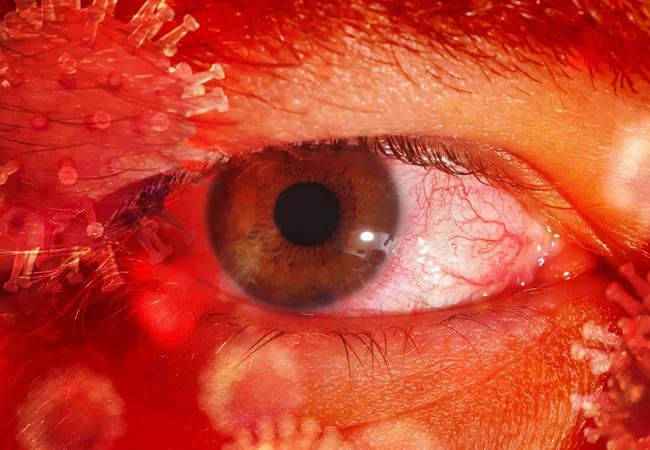A review of the latest on clinical features and transmission

Conjunctivitis and conjunctivitis-like symptoms are the most prevalent ophthalmic presentations of COVID-19 infection. One recent meta-analysis involving nearly 2,000 patients with COVID-19 found that up to 8% had conjunctivitis or conjunctival injection.
Cleveland Clinic is a non-profit academic medical center. Advertising on our site helps support our mission. We do not endorse non-Cleveland Clinic products or services. Policy
However, overall knowledge of the potential impact of COVID-19 on the eye and ocular structures remains in its infancy. In addition to conjunctivitis, reports are emerging of maculopathy, retinal vascular alterations, neuroretinitis, oculomotor nerve paresis, and nonspecific symptoms like photophobia, dry eye and blurry vision. More studies will help to better elucidate the impact of COVID-19 on retinal vasculature, the neural retina and the optic nerve. A small fraction of COVID-19 patients (0.9% in one study) actually present with ophthalmic symptoms as their initial complaint.
While new data on COVID-19 and the eye are emerging, Sari Yordi, MD, and Justis P. Ehlers, MD, both of Cleveland Clinic’s Cole Eye Institute, recap recent findings in Cleveland Clinic Journal of Medicine. Their review is part of the publication’s COVID-19 Curbside Consults series.
“In ophthalmology, there is an opportunity to explore the disease effects from a unique perspective with a potential to recognize the disease early and aid in its management,” write the authors.
Ophthalmic symptoms of COVID-19 — noted in both inpatient and outpatient settings — are challenging to evaluate.
“The novel nature of the virus, the unclear prevalence of concurrent ophthalmic disease, its high infectivity, and potentially life-threatening complications all limit data acquisition and ancillary testing,” say Drs. Yordi and Ehlers.
The authors explain that while viral shedding of SARS-CoV-2 through respiratory droplets may last for weeks after onset of symptoms, the potential duration for viral shedding in tears and conjunctival secretions is unclear. Study results have been mixed on the incidence of viral presence in tears. One case series of 43 patients showed SARS-CoV-2 in the tears of three patients (7%) with COVID-19. However, an analysis of 338 patients had lower detection rates, ranging from 0% to 5%. In addition, the presence of the virus in conjunctival secretions was not associated with the presence of conjunctival symptoms, further complicating the assessment of ophthalmic viral shedding.
Regardless of the unclear data on viral particle presence in tears, the authors emphasize that COVID-19 can spread through respiratory droplets from infected patients to surfaces in eye examination rooms. Drs. Yordi and Ehlers recap safety protocols for eye care practices recommended by the American Academy of Ophthalmology, which include eye protection for clinicians and cleaning equipment with virucidal wipes between each appointment.
The article concludes with recommendations for primary care providers who encounter patients with COVID-19 and ophthalmic symptoms. Currently there are no distinguishing factors between typical viral conjunctivitis and COVID-19-related conjunctivitis. Similar to traditional viral conjunctivitis, first-line therapy remains artificial tears and cold compresses. Referral to ophthalmology is warranted if diplopia or loss in visual acuity is detected.
Free access to the full article (with references) is available from Cleveland Clinic Journal of Medicine.

Patients report improved sense of smell and taste

Clinicians who are accustomed to uncertainty can do well by patients

Unique skin changes can occur after infection or vaccine

Cleveland Clinic analysis suggests that obtaining care for the virus might reveal a previously undiagnosed condition

As the pandemic evolves, rheumatologists must continue to be mindful of most vulnerable patients

Early results suggest positive outcomes from COVID-19 PrEP treatment

Could the virus have caused the condition or triggered previously undiagnosed disease?

Five categories of cutaneous abnormalities are associated with COVID-19